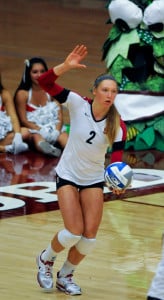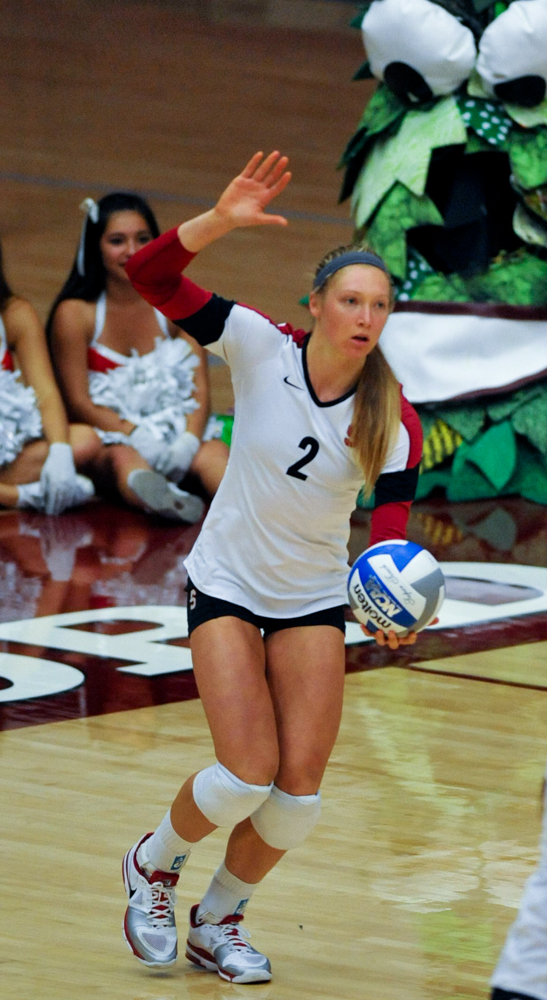Entering the 2013 season, Stanford women’s volleyball had an opportunity to take advantage of a rarity in college sports — the return of its entire starting lineup from the previous season. The young team, with a core of five sophomores, anchored by senior captain and middle blocker Carly Wopat, had its sights set on an NCAA-record seventh national championship and the school’s first since 2004.

The Cardinal (27-6, 17-3 Pac-12), which finished the postseason ranked fifth in the nation, had streaks of dominance throughout the season en route to its 33rd consecutive NCAA tournament appearance, but also faced some adversity — the Cardinal finished with just a 5-6 record against ranked opponents. The team finished second in the Pac-12 behind Washington and ultimately fell in the Elite Eight to eventual national champion Penn State.
After sweeping its first two matches of the season against UC-Santa Barbara and Pacific, the Cardinal headed to Austin, Tex., for the Nike Volleyball Big Four Classic, its yearly trip to play the nation’s top teams in preparation for a tough conference slate. The team suffered quick four-set losses to No. 8 Florida and No. 6 Texas, thanks in part to serving issues (3.57 service errors per set in the team’s first four matches) and defensive challenges.
Extended serving practices then became a staple in Stanford’s workouts throughout the season, and the players reevaluated their efforts on defense.
“It took giving that extra effort that [the sophomores] all had last year when we were young and trying to prove ourselves — it takes even more to do it the second year,” said sophomore middle blocker Inky Ajanaku. “By the end, I feel that our defense was one of the things that got us so far in the tournament.”
Stanford’s youth was also on display against quality opponents early on in the season. With the starting lineup featuring four sophomores, the team simply hadn’t had as much experience playing with each other as other veteran squads.
“I don’t think we were very poised. I don’t think we were very tough. And we had to go through the season to learn some things about ourselves, about how you have to be in the big moments,” said head coach John Dunning. “We were still a young team at that point.”
The Cardinal rebounded after its tough losses in Austin, winning its next eight matches — a stretch in which it only dropped two sets. Almost everything was working, as the team hit .356 over the winning streak with 1.7 aces per set. But in its trip to the Galen Center to face then-No. 2 USC on Oct. 4, Stanford was swept for the first time since October 2011.
The Cardinal won five matches in October, but it was a relatively tough month for the team, as it suffered two difficult five-set losses to ranked opponents: away at No. 6 Washington and at home against No. 4 USC — Stanford’s first home loss in 24 matches. However, the defeat at Maples proved to be the turning point in the team’s season.
Coaches and players stressed renewing focus and maintaining composure in high-pressure situations after the USC match, and a recharged team dynamic led to a season-long nine-match winning streak to end the regular season. Straight-set victories on the road at high altitude against Colorado and Utah at the beginning of November preceded the Card’s marquee win of the season — a sweep against then-No. 3, and eventual conference champion Washington on Nov. 20.
In 96 minutes (including an intermission), Stanford completely dominated the Huskies, limiting the Pac-12’s best servers to just one ace in the match and using the good defense to create a strong offensive attack. The Cardinal defense held its opponent to a .167 hitting percentage, key to handing Washington its only straight-set loss of the regular season.
“[The win] gave us that same mentality that we had last year that we were all searching for — that fearless mentality,” Ajanaku said, “which was what we decided to be our theme this year. I don’t think we really felt it until we beat Washington.”
Sophomore setter Madi Bugg, who was named an AVCA Second-Team All-American and the Pac-12 Setter of the Year, was key in the win and throughout the season, anchoring Stanford’s balanced offense with her ability to distribute the ball to both the pins and the middles.
“We’re one of the teams that can either use our middles to beat people, or make people worry about our middles and instead beat them somewhere else,” Dunning said prior to the NCAA tournament. “We have balance, and everybody knows it.”
After taking down Hampton, Oklahoma, and Minnesota in the NCAA tournament all in straight sets, Stanford played Big Ten champion Penn State in the Lexington, Ky. regional final. It was the team’s toughest matchup of the season, pairing the Card’s third-ranked block with the Nittany Lions’ top block in the nation. It was a thrilling five-set match more suited for the Final Four, as the teams were never separated by more than five points.
Stanford jumped out to a quick lead in the match, winning the first game 25-22 after being down 19-15 late in the set. The team then fell behind two games to one after Penn State rallied, but the Card battled back and dominated the fourth game to take the match to a first-to-15 fifth set. Stanford even jumped out to a 9-6 lead in the final set, but Penn State’s defense, led by senior middle hitter Katie Slay, repeatedly denied the Cardinal attempts with a strong block. The Nittany Lions later took the fifth game 15-11.
Despite Stanford’s loss, Dunning said it was by far the best match they played on the season.
It was the last match for the Cardinal seniors, including Wopat and outside hitter Rachel Williams, the 13th and 14th players to record 1,000 career kills for Stanford since 1986. Wopat, a two-time AVCA First-Team All-American, was a consistent force on the court and her strong net presence will especially be missed, as her 614 career blocks rank third in Stanford history.
“Everybody can recognize that Carly has been an All-American and her level of play on any given day. But more than that, it’s how much did the team benefit from her just obvious competitive spirit? How much did the team benefit from Rachel stepping up and saying, ‘We have to do things that help the team and not just our individual selves,’” Dunning said. “[Mary-Ellen Luck] and [Lydia Bai] were just kind of more quiet but solid people, doing the things you have to do every day.”
Though younger players will have to step up to replace the graduating seniors in the starting lineup, Stanford will return four AVCA All-Americans in 2014. Ajanaku is sure to be one of the leaders on the team, coming off one of the best single-season performances in school history. The first-team All-American hit .438, the third-best single-season mark in Stanford history — good for ninth-best in the country this year.
While the team wasn’t able to accomplish everything it set out to achieve this season, a core of five rising juniors leaves a two-year window of opportunity to achieve the program’s yearly goal of winning a national title.
“Everybody knows that when we get back in the next couple of weeks that we’re going to start over,” Dunning said. “We’re not talking about who played last year, we’re not talking about who redshirted. We’re going to walk into the gym and say, ‘We know what we learned. We know where we are.’ We’re going to get after it because the process renews itself right now.”
Contact Jordan Wallach at jwallach ‘at’ stanford.edu.
